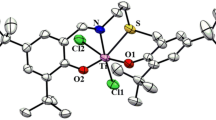Abstract
The interaction of the [Ni(PPh3)3]BF4 complex with styrene and the products of styrene conversion in the polymerization reaction were studied by EPR and 13C NMR spectroscopy. The structure of the σ-carbocationic complex of Ni(I) formed by the interaction of styrene with the [Ni(PPh3)3]BF4 cationic phosphine complex of Ni(I) was characterized in detail. It was found that the reaction of styrene polymerization occurred with the participation of the coordination center of the σ-carbocationic complex (coordination catalysis), whereas the reaction of telomerization occurred with the participation of the cationic center of this complex (ionic catalysis). The resulting polymer contained active terminal double bonds; it is a promising macromonomer for the synthesis of grafted copolymers. The discovered capacity of alcohols to undergo nucleophilic addition to a growing polymer chain offers strong possibilities for preparing functional polymers and block copolymers.
Similar content being viewed by others
REFERENCES
Fel'dblyum, V.Sh., Dimerizatsiya i disproportsionirovanie olefinov (Dimerization and Disproportionation of Olefins), Moscow: Khimiya, 1978.
Bogdanovic, B., Adv. Organomet. Chem., 1979, p. 105.
Keim, W., Angew. Chem., Int. Ed. Engl., 1990, p. 235.
Shmidt, F.K., Kataliz kompleksami metallov pervogo perekhodnogo ryada reaktsii gidrirovaniya i dimerizatsii (Hydrogenation and Dimerization Catalyzed by Complexes of First-Row Transition Metals), Irkutsk: Irkutsk. Gos. Univ., 1986.
Klabunde, U., Tulip, T.H., Roe, D.C., and Ittel, S.D., J. Organomet. Chem., 1987, p. 141.
Tomov, A. and Kurtev, K., J. Mol. Catal. A, 1995, vol. 103, p. 55.
Pellecchia, C., Zambelli, A., Oliva, L., and Pappalardo, D., Macromolecules, 1996, vol. 29, p. 6990.
Feldman, J., McLain, S.J., Parthasarathy, A., et al., Organometallics, 1997, vol. 16, p. 1514.
Schleis, T., Spaniol, T.P., Okuda, J., et al., J. Organomet. Chem., 1998, vol. 569, p. 159.
Peruch, F., Cramail, H., and Deffieux, A., Macromolecules, 1999, vol. 32, p. 7977.
Koppl, A. and Alt, H.G., J. Mol. Catal. A, 2000, vol. 154, p. 45.
Milano, G., Guerra, G., Pellecchia, C., and Cavallo, L., Organometallics, 2000, vol. 19, p. 1343.
Heinicke, J., Koesling, M., Bruell, R., et al., Eur. J. Inorg. Chem., 2000, vol. 2, p. 299.
Lee, B.Y., Bazan, G.C., Vela, J., Komon, Z.J., et al., J. Am. Chem. Soc., 2001, vol. 123, p. 5352.
Soula, R., Broyer, J.P., Llauro, M.F., et al., Macromolecules, 2001, vol. 34, p. 2438.
Hicks, F.A. and Brookhart, M., Organometallics, 2001, vol. 20, p. 3217.
Preishuber-Pflugl, P. and Brookhart, M., Macromolecules, 2002, vol. 35, p. 6074.
Schroder, D.L., Keim, W., Zuideveld, M.A., and Mecking, S., Macromolecules, 2002, vol. 35, p. 6071.
Daugulis, O. and Brookhart, M., Organometallics, 2002, vol. 21, p. 5926.
Jenkins, J.C. and Brookhart, M., Organometallics, 2003, vol. 22, p. 250.
Carlini, C., Raspolli Galletti A.M., Sbrana G., and Caretti D, Polymer, 2001, vol. 42, p. 5069.
Saraev, V.V., Kraikivskmi, P.B., Zelinskii, S.N., et al., Koord. Khim., 2001, vol. 27, no.2, p. 136.
Saraev, V.V., Tkach, V.S., Kraikivskii, P.B., et al., Koord. Khim., 1998, vol. 24, no.8, p. 602.
Kraikivskii, P.B., Saraev, V.V., Matveev, D.A., et al., Koord. Khim., 2003, vol. 29, no.6, p. 461.
Saraev, V.V., Kraikivskii, P.B., Lazarev, P.G., et al., Koord. Khim., 1996, vol. 22, no.9, p. 648.
Koptyug, V.A., Arenonievye iony. Stroenie i reaktsionnaya sposobnost' (Arenonium Ions: Structure and Reactivity), Novosibirsk: Nauka, 1983.
Gordon, A.J. and Ford, R.A., A Handbook of Practical Data, Techniques, and References, New York: Wiley, 1972.
Tkach, V.S., Gruznykh, V.A., Murasheva, N.A., and Shmidt, F.K., Koord. Khim., 1990, vol. 16, no.4, p. 574.
Rabek, J.F., Experimental Methods in Polymer Chemistry, New York: Wiley, 1980, vol. 1.
Praktikum po vysokomolekulyarnym soedineniyam (Practical Course of Polymers), Kabanov, V.A., Ed., Moscow: Khimiya, 1985, p. 224.
Saraev, V.V., Kraikivskii, P.B., Lazarev, P.G., et al., Koord. Khim., 1996, vol. 22, no.9, p. 655.
Author information
Authors and Affiliations
Additional information
__________
Translated from Kinetika i Kataliz, Vol. 46, No. 5, 2005, pp. 757–763.
Original Russian Text Copyright © 2005 by Saraev, Kraikivskii, Annenkov, Vil'ms, Matveev, Danilovtseva, Ermakova, Kuznetsova, Lammertsma.
Rights and permissions
About this article
Cite this article
Saraev, V.V., Kraikivskii, P.B., Annenkov, V.V. et al. Cationic Complexes of Monovalent Nickel as Catalysts for Styrene Polymerization. Kinet Catal 46, 712–718 (2005). https://doi.org/10.1007/s10975-005-0126-4
Received:
Issue Date:
DOI: https://doi.org/10.1007/s10975-005-0126-4




